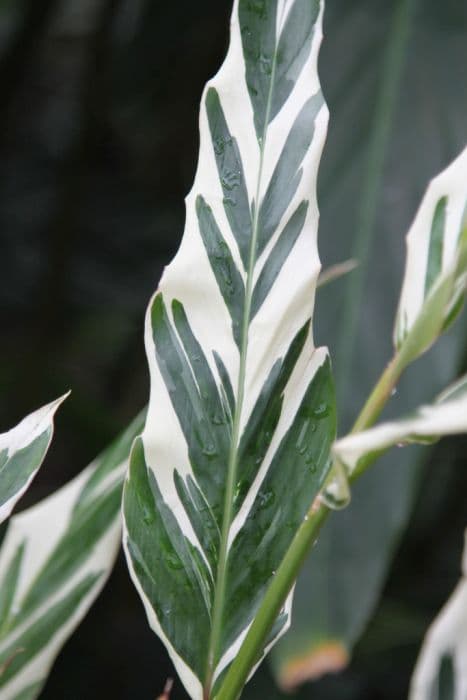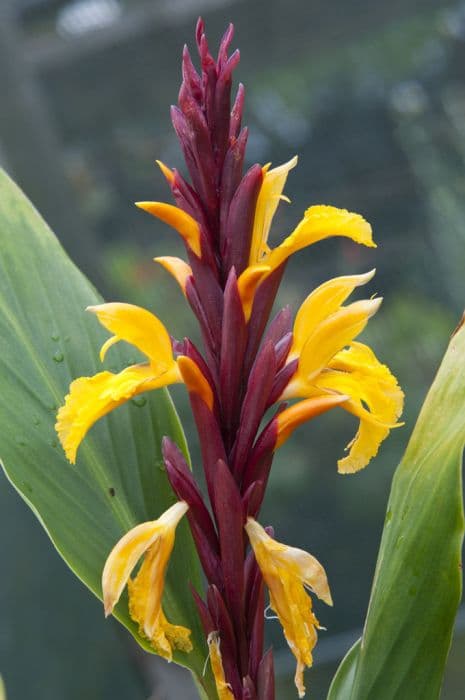Roscoea Roscoea 'Harvington Evening Star'

ABOUT
The Roscoea 'Harvington Evening Star' is a perennial plant that exhibits a stunning array of colors and structural beauty. Its most striking feature is the vibrant flowers, which showcase a rich purple hue. These blooms have a unique shape that resembles exotic orchids, with delicate petals that may have lighter or darker tones, creating an enchanting contrast. The center of the flowers is often accentuated with a splash of color, and the petals carry a gentle, graceful curve. Surrounding the flowers, the foliage of 'Harvington Evening Star' adds to its appeal. The leaves are elongated and lance-shaped, presenting a lush green color that creates a lovely backdrop for the dramatic flowers. The leaves sprout from the base of the plant, forming a rosette-like arrangement that is both tidy and attractive. The overall look of the Roscoea 'Harvington Evening Star' is one of elegance and exotic charm, drawing the eye with its colors and the architectural quality of its flowers and foliage. It brings a touch of the unique to garden settings or containers where it can be admired for its ornamental qualities.
About this plant
 Names
NamesFamily
Zingiberaceae.
Synonyms
Hardy Ginger, Ginger Root.
Common names
Roscoea 'Harvington Evening Star'.
 Toxicity
ToxicityTo humans
Roscoea purpurea, commonly known as Roscoea, is not widely recognized as a toxic plant to humans. There is limited information regarding its toxicity, and it is not typically considered a plant that poses a risk if ingested. However, like with any plant, individual sensitivities can vary, and it is always advisable to avoid eating plants that are not commonly recognized as food items to prevent potential adverse effects from unknown compounds.
To pets
Similar to its effects on humans, Roscoea is not commonly known to be toxic to pets. There is a lack of documented toxicity in domestic animals from ingesting this plant. As with humans, pets may have individual sensitivities, and it is generally recommended to prevent pets from consuming non-food plants to avoid potential gastrointestinal discomfort or other unpredictable reactions.
 Characteristics
CharacteristicsLife cycle
Perennials
Foliage type
Deciduous
Color of leaves
Green
Flower color
Purple
Height
1-2 feet (30-60 cm)
Spread
0.5-1 feet (15-30 cm)
Plant type
Herb
Hardiness zones
6
Native area
Himalayas
Benefits
 General Benefits
General Benefits- Aesthetic Appeal: Adds elegant blooms with its purple flowers to gardens and landscapes.
- Low Maintenance: Requires minimal care once established, making it ideal for busy gardeners.
- Drought Resistance: Tolerates periods of low water once established, suitable for drier climates.
- Attracts Pollinators: Flowers attract bees, beneficial for pollination of gardens and ecosystems.
- Cold Hardy: Resistant to cold temperatures, allowing it to thrive in cooler climates.
- Long Bloom Season: Offers long flowering periods, providing color and interest for an extended time.
- Compact Growth: Its moderate size makes it suitable for small gardens or confined spaces.
- Versatile Planting: Can be used in a variety of garden designs, including borders, containers, and rock gardens.
 Medical Properties
Medical PropertiesThis plant is not used for medical purposes.
 Air-purifying Qualities
Air-purifying QualitiesThis plant is not specifically known for air purifying qualities.
 Other Uses
Other Uses- Roscoea 'Harvington Evening Star' can be used in the art of flower pressing due to its attractive blossoms, creating lasting decorative pieces for crafts or keepsakes.
- The vibrant petals of the Roscoea can be used as a natural dye for fabrics or artworks, giving a unique and organic color to materials.
- This plant's sturdy leaves can be used for eco-friendly packaging or as a biodegradable alternative to plastic when wrapping small items.
- Roscoea 'Harvington Evening Star' may be integrated into educational gardens or botanical displays to teach about perennial plants and pollinator attractions.
- Those practicing the art of Ikebana, Japanese flower arranging, could utilize Roscoea's blooms to add an exotic flair to their arrangements.
- The plant can serve as a subject for botanical illustration, allowing artists to study and depict its form and color in detail.
- In culinary arts, petals of the Roscoea can be used as an ornamental garnish for dishes, adding a splash of color to the presentation.
- Roscoea can play a role in sensory gardens, providing a unique texture and shape for visitors to explore through touch and sight.
- The plant may be used in photography as a foreground or background subject, enhancing garden and nature photography with its striking presence.
- The name 'Harvington Evening Star' could inspire thematic garden designs or storytelling, associating the plant with celestial or twilight motifs.
Interesting Facts
 Feng Shui
Feng ShuiThe Roscoea is not used in Feng Shui practice.
 Zodiac Sign Compitability
Zodiac Sign CompitabilityThe Roscoea is not used in astrology practice.
 Plant Symbolism
Plant Symbolism- Resilience: Roscoes thrive in harsh mountain regions, making them a symbol of strength and an ability to overcome challenging conditions.
- Rarity: The 'Harvington Evening Star', with its unique beauty, is not a commonly found plant and can represent something precious or rare in one’s life.
- Serenity: The plant's gentle appearance and preference for partial shade convey a sense of calm, offering a symbol of peace and tranquility.
- Harmony with Nature: As a plant that blends well with other garden species, it symbolizes the importance of coexistence and balance in the natural world.
- Elegance: The sophisticated look of the 'Harvington Evening Star' blooms signifies grace and refined beauty in the plant world.
 Water
WaterThe Roscoea, also known as Hardy Ginger, prefers consistently moist soil, especially during the growing season. It should be watered thoroughly once the top inch of soil feels dry to the touch. Depending on the climate and weather conditions, this might equate to watering once or twice a week. Use enough water to moisten the soil all the way to the roots but avoid waterlogging. As a general guide, you might use approximately 1 gallon of water per week for an established plant, adjusting based on temperature and rainfall.
 Light
LightHardy Ginger thrives best in partial shade, where it can receive filtered sunlight or morning sun with afternoon shade. The ideal spot for this plant would be an east-facing garden that avoids the intense heat of the midday and afternoon sun. It can handle a few hours of full sun in cooler climates, but too much direct sunlight can scorch the leaves.
 Temperature
TemperatureHardy Ginger prefers cooler temperatures and is hardy in a range of climates. It can typically survive winter temperatures down to about 0 degrees Fahrenheit but is happiest when temperatures are between 60 and 75 degrees Fahrenheit during the growing season. The warmer end of this range is ideal for flowering and growth, but it's important to ensure that the plant does not overheat in summer.
 Pruning
PruningPruning Hardy Ginger is mainly done to remove dead or damaged foliage and to maintain a tidy appearance. It is best to prune the plant in early spring before new growth begins. Cut back any old stems to ground level. Pruning can also be performed after flowering if necessary to shape the plant or remove spent flower spikes, but minimal pruning is typically required.
 Cleaning
CleaningAs needed
 Soil
SoilRoscoea, commonly known as Himalayan ginger, prefers a moisture-retentive yet well-draining soil mix composed of loam, sand, and peat or leaf mold. A slightly acidic to neutral soil pH of 6.5 to 7.5 is ideal to support the healthy growth of 'Harvington Evening Star'.
 Repotting
RepottingHimalayan ginger should be repotted every 2-3 years, or when it becomes root-bound. The best time to repot is in the spring before active growth begins.
 Humidity & Misting
Humidity & MistingHimalayan ginger thrives best in an environment with high humidity levels, ideally between 60-70%, which supports its lush foliage and vibrant blooms.
 Suitable locations
Suitable locationsIndoor
Place Himalayan ginger in bright, indirect light with high humidity.
Outdoor
Plant in partial shade, protect from afternoon sun, ensure moist soil.
Hardiness zone
6-9 USDA
 Life cycle
Life cycleThe life cycle of Roscoea 'Harvington Evening Star', also known as Hardy Ginger, starts with seed germination, which typically occurs in moist and warm conditions after a period of stratification. After germination, the plant develops a small rhizome from which the first shoots and roots emerge. As the season progresses, this perennial plant grows larger foliage and then develops distinctive orchid-like flowers during the summer months, which can be purple, pink, or white depending on the specific variety. After pollination, flowers will produce seed capsules if pollinators are present. In autumn, the above-ground parts of the plant die back as the plant enters a period of dormancy during the colder winter months. The plant's life cycle resumes the following spring when temperatures rise and the rhizome generates new growth, starting the cycle anew.
 Propogation
PropogationPropogation time
Spring to Early Summer
The most popular method for propagating Roscoea 'Harvington Evening Star', commonly known as Hardy Ginger, is by division. The best time to carry out this method is in the spring, just before new growth begins. To propagate by division, carefully lift the parent plant from the ground and gently shake off any excess soil to expose the rhizomes. Using a sharp knife, divide the rhizomes into sections, ensuring that each piece has at least one growth bud. Replant these sections immediately at the same depth they were originally growing, and water them well. Divisions should be spaced about 12 inches (30 centimeters) apart to allow each new plant enough room to grow. This method is efficient and maintains the characteristics of the parent plant.









